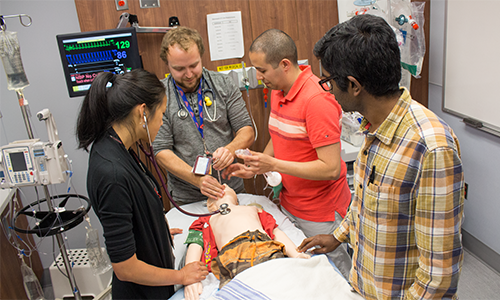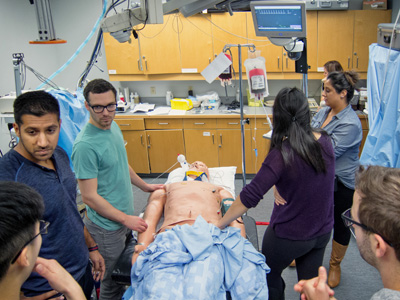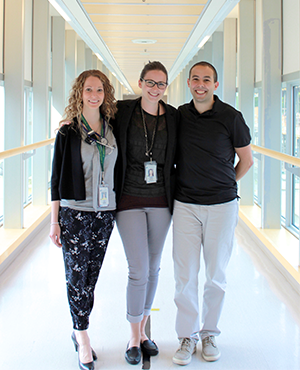
Pediatric residents (left to right) Rachel Li, Matt Carwana, Anas Manouzi and Badri Narayan at the BC Children’s Pediatric Simulation Centre.
When it comes to handling medical emergencies, UBC pediatric residents Anas Manouzi, Haley deVries and Victoria Cook are no strangers. Over the course of their training at BC Children’s Hospital in Vancouver, they’ve witnessed septicemia in newborns, obstructed airways in toddlers and severe head traumas in older children.
Yet, some of their most critical encounters didn’t unfold on the ward. Instead, they took place in the safety of the hospital’s Pediatric Simulation Centre, a state-of-the art facility equipped with over 20 rooms and a series of high-fidelity mannequins that breathe, cough, talk, and — at the press of a button — can even turn blue.
“Simulation is a very powerful tool,” says Dr. Manouzi, who is among one of nearly 60 residents in UBC’s Pediatric Residency Program. “The Centre really allows us, as medical residents, to ‘practice until we get things perfect.’”
Since its doors first opened in 2012, the Pediatric Simulation Centre at BC Children’s has been in high demand by practicing physicians, midwives, nurses, respiratory therapists and other healthcare professionals looking to hone their medical skills in a risk-free environment.
And for pediatricians-in-training, the centre has become like a second home. Every Tuesday afternoon, teams of pediatric residents can be found re-creating entire clinical situations during their academic half days.
But, only a short time ago, the picture looked very different.
“A few years ago, it would have been rare to be exposed to more than three or four simulations over the course of the entire year,” recalls Dr. Manouzi.

Related story: Lessons from the cockpit
In POEM, a mix of residents learn to “flatten the hierarchy” and use “closed-loop communication.”
It wasn’t until a new multi-year — and resident-led — simulation curriculum was first introduced in 2013 that everything changed.
“Pediatric residents want to be challenged. They want to see tough cases, and to learn how to manage those scenarios in a safe environment,” says Dr. Manouzi, who helped design and implement the expanded acute care simulation curriculum alongside fellow pediatric residents, Drs. deVries and Cook.
Today, thanks to the trio’s hard work, UBC pediatric trainees are exposed to upwards of 30 critical care simulations over the course of their time in the program — a three-fold increase from only a few years ago.
According to Laura Sauvé, Pediatric Residency Co-Program Director, the increased simulation experience is paying off.
“When we have a real emergency, our residents work much more smoothly now than they did in the past. Our residents are better equipped to respond because they’ve had an opportunity to practice it in a simulation setting,” says Dr. Sauvé.
Pediatric residents, like Matt Carwana, agree.
“When I’m on the ward or in the emergency room, I draw on what I’ve been learning in simulation in order to provide better, more efficient care. You have more confidence because you have seen it before,” says Dr. Carwana.
“It’s amazing how real the scenarios feel when you’re doing them in simulation. Your heart beats like it’s a real life or death situation and the team is functioning like it is a real, acute scenario,” he adds.
And it’s not just anecdotal evidence pointing to an improvement in the residents’ performance and overall confidence. In a 2014 survey of pediatric residents who participated in the program, 88 per cent of respondents reported feeling an improvement in their performance.
“I’m so proud of what we’ve accomplished in such a short time,” Dr. deVries says. “The three of us worked as a true team and were all involved equally in the curriculum inception and development, case design, logistics planning and implementation, and quality assurance.”
“Leading this program has been an incredible opportunity for professional development. We now have first-hand experience with designing and maintaining a curriculum, and we’ve also been able to delve into the research side of simulation,” says Dr. Cook, who presented findings from their research at the 2015 International Pediatric Simulation Symposium last spring, where the trio earned one of the top awards for their poster.

Victoria Cook, Haley deVries and Anas Manouzi implemented an expanded acute care simulation curriculum.
But like any endeavor, success of the expanded simulation program would not have been possible without strong support from fellow pediatric residents, and the dedication of a larger team of health professionals at BC Children’s, including: Mary Bennett, Associate Head, Education, Department of Pediatrics; Dr. Sauvé and Janet Greenman, Co-Program Directors, Pediatric Residency Program; respiratory therapist Debbie Cain; pediatric emergency nurse Jackie Allen; simulation coordinator Karen Schafer; and simulation technician Richard Pinto; as well as the BC Children’s Hospital Foundation.
“The community at BC Children’s has been so supportive of this resident-led initiative. Many have not only volunteered their time and energy helping the residents develop cases, but also supervise and debrief the simulations,” Dr. Sauvé says.
And while the team is no longer directly involved in the week-to-week management of the curriculum, the program is still going strong, thanks to the foresight of the trio, who trained a new wave of pediatric residents to manage the program going forward.
“I really give them a lot of credit because they’ve put an incredible amount of energy into this project, and they’ve also put a lot of thought into sustainability,” Dr. Sauvé says.
In the years to come, Drs. Manouzi, deVries and Cook hope to stay connected and help the program evolve.
“Learner-generated enthusiasm is infectious,” Dr. deVries says. “Residents and fellows are in a position to know not only what we want to learn, but also how we want to learn. We have a responsibility to our patients to pursue the highest quality training, and that is a strong motivating force for all of us.”